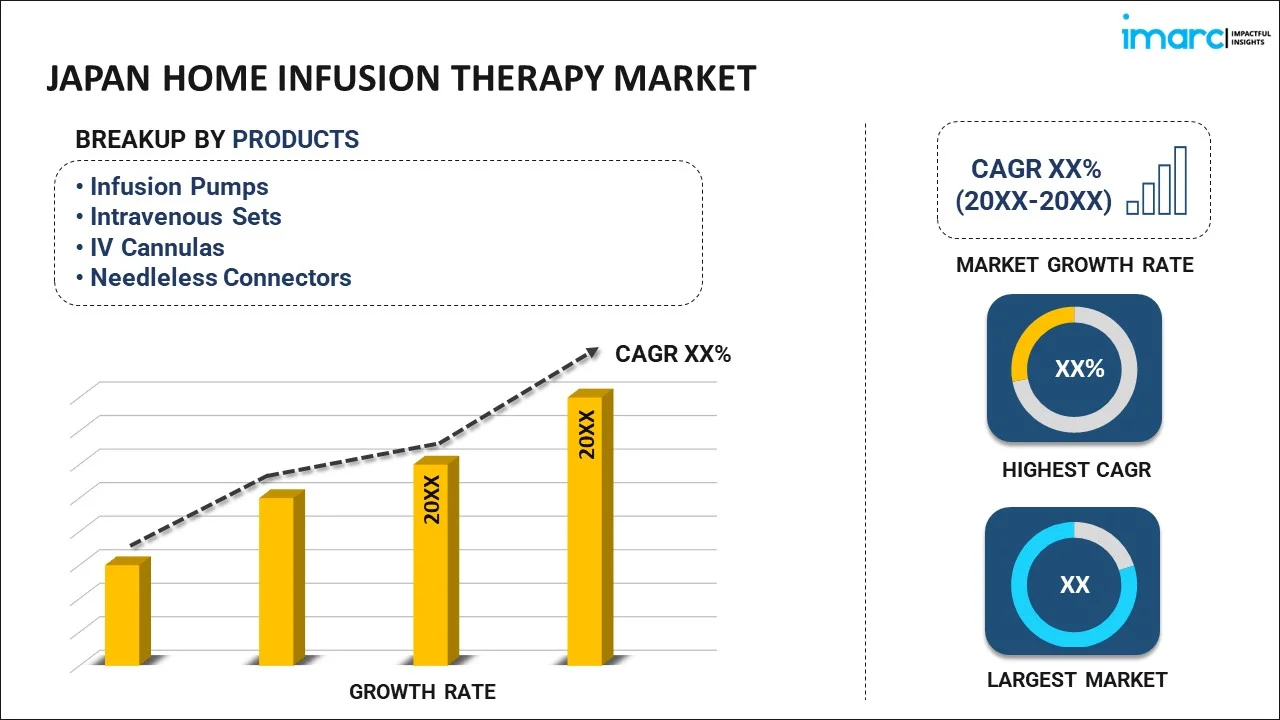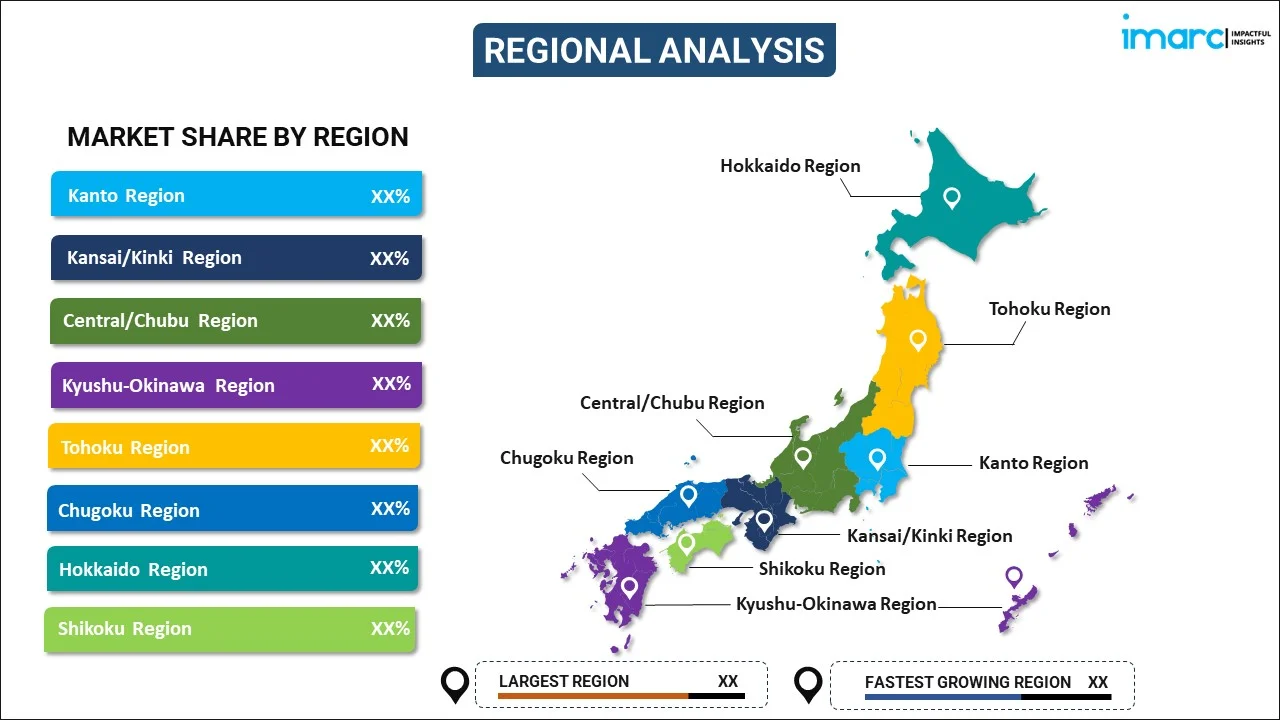
Japan Home Infusion Therapy Market Report by Product (Infusion Pumps, Intravenous Sets, IV Cannulas, Needleless Connectors), Application (Anti-Infective, Endocrinology, Hydration Therapy, Chemotherapy, Enteral Nutrition, Parenteral Nutrition, Specialty Pharmaceuticals, and Others), and Region 2025-2033
Market Overview:
Japan home infusion therapy market size reached USD 2,685.0 Million in 2024. Looking forward, IMARC Group expects the market to reach USD 4,782.3 Million by 2033, exhibiting a growth rate (CAGR) of 6.6% during 2025-2033. The growing incidence of chronic illnesses, the rising inclination towards home healthcare, and continuous advancements in product offerings are among the primary factors propelling the market growth.
|
Report Attribute
|
Key Statistics
|
|---|---|
|
Base Year
|
2024
|
|
Forecast Years
|
2025-2033
|
|
Historical Years
|
2019-2024
|
|
Market Size in 2024
|
USD 2,685.0 Million |
|
Market Forecast in 2033
|
USD 4,782.3 Million |
| Market Growth Rate 2025-2033 | 6.6% |
Home infusion therapy is a specialized medical treatment that involves delivering medications, such as antivirals or immune globulin, fluids, or nutrition intravenously to patients in the comfort of their homes, utilizing various equipment like pumps, catheters, and vials. This form of therapy is recommended for individuals dealing with infections, cancer, or chronic conditions like multiple sclerosis (MS) or rheumatoid arthritis that necessitate long-term or frequent infusion treatment. Home infusion therapy provides a sense of comfort and convenience, enhances the overall quality of life, and diminishes the risk of hospital-acquired infections. Moreover, it empowers patients by allowing them to maintain a sense of independence and control over their treatment while still receiving essential medical care. Home infusion therapy is particularly effective in diverse treatments, including chemotherapy, hydration, enteral, inotropic, anti-infective, nutritional, and pain management therapies, commonly employed for conditions such as diabetes and various gastrointestinal and oncological disorders.
Japan Home Infusion Therapy Market Trends:
The Japan home infusion therapy market is witnessing substantial growth, driven by an increase in the prevalence of chronic diseases like cancer, osteoarthritis, human immunodeficiency viruses (HIV), and diabetes. The expanding geriatric population, more susceptible to life-threatening illnesses requiring regular medical attention, particularly infusion therapy, is also contributing significantly to market growth. Besides this, government initiatives, favorable reimbursement policies, and the rising costs associated with prolonged hospital stays are motivating patients to opt for home infusion therapy, further fueling market expansion. Additionally, the growing preference for home healthcare services due to their convenience and cost-effectiveness, coupled with the increasing strain on hospital resources, is acting as another significant growth-inducing factor. Apart from this, the rise in hospital-acquired infections (HAIs) due to prolonged exposure to contaminated equipment, bed linens, and air droplets is amplifying the market's expansion. The widespread demand for specialty drugs, necessitating specialized administration, adds another layer of growth to the market. Furthermore, innovative technological advancements, such as the development of lightweight, portable, and user-friendly infusion pumps equipped with advanced drip systems for precise and real-time monitoring of IV treatments, are anticipated to fuel the market growth over the forecasted period.
Japan Home Infusion Therapy Market Segmentation:
IMARC Group provides an analysis of the key trends in each segment of the market, along with forecasts at the country level for 2025-2033. Our report has categorized the market based on product and application.
Product Insights:

- Infusion Pumps
- Elastomeric
- Electromechanical
- Gravity
- Others
- Intravenous Sets
- IV Cannulas
- Needleless Connectors
The report has provided a detailed breakup and analysis of the market based on the product. This includes infusion pumps (elastomeric, electromechanical, gravity, and others), intravenous sets, IV cannulas, and needleless connectors.
Application Insights:
- Anti-Infective
- Endocrinology
- Diabetes
- Others
- Hydration Therapy
- Athletes
- Others
- Chemotherapy
- Enteral Nutrition
- Parenteral Nutrition
- Specialty Pharmaceuticals
- Others
A detailed breakup and analysis of the market based on the application have also been provided in the report. This includes anti-infective, endocrinology (diabetes and others), hydration therapy (athletes and others), chemotherapy, enteral nutrition, parenteral nutrition, specialty pharmaceuticals, and others.
Regional Insights:

- Kanto Region
- Kansai/Kinki Region
- Central/ Chubu Region
- Kyushu-Okinawa Region
- Tohoku Region
- Chugoku Region
- Hokkaido Region
- Shikoku Region
The report has also provided a comprehensive analysis of all the major regional markets, which include Kanto Region, Kansai/Kinki Region, Central/ Chubu Region, Kyushu-Okinawa Region, Tohoku Region, Chugoku Region, Hokkaido Region, and Shikoku Region.
Competitive Landscape:
The market research report has also provided a comprehensive analysis of the competitive landscape. Competitive analysis such as market structure, key player positioning, top winning strategies, competitive dashboard, and company evaluation quadrant has been covered in the report. Also, detailed profiles of all major companies have been provided.
Japan Home Infusion Therapy Market Report Coverage:
| Report Features | Details |
|---|---|
| Base Year of the Analysis | 2024 |
| Historical Period | 2019-2024 |
| Forecast Period | 2025-2033 |
| Units | Million USD |
| Scope of the Report | Exploration of Historical and Forecast Trends, Industry Catalysts and Challenges, Segment-Wise Historical and Predictive Market Assessment:
|
| Products Covered |
|
| Applications Covered |
|
| Regions Covered | Kanto Region, Kansai/Kinki Region, Central/ Chubu Region, Kyushu-Okinawa Region, Tohoku Region, Chugoku Region, Hokkaido Region, Shikoku Region |
| Customization Scope | 10% Free Customization |
| Post-Sale Analyst Support | 10-12 Weeks |
| Delivery Format | PDF and Excel through Email (We can also provide the editable version of the report in PPT/Word format on special request) |
Key Questions Answered in This Report:
- How has the Japan home infusion therapy market performed so far and how will it perform in the coming years?
- What has been the impact of COVID-19 on the Japan home infusion therapy market?
- What is the breakup of the Japan home infusion therapy market on the basis of product?
- What is the breakup of the Japan home infusion therapy market on the basis of application?
- What are the various stages in the value chain of the Japan home infusion therapy market?
- What are the key driving factors and challenges in the Japan home infusion therapy?
- What is the structure of the Japan home infusion therapy market and who are the key players?
- What is the degree of competition in the Japan home infusion therapy market?
Key Benefits for Stakeholders:
- IMARC’s industry report offers a comprehensive quantitative analysis of various market segments, historical and current market trends, market forecasts, and dynamics of the Japan home infusion therapy market from 2019-2033.
- The research report provides the latest information on the market drivers, challenges, and opportunities in the Japan home infusion therapy market.
- Porter's five forces analysis assist stakeholders in assessing the impact of new entrants, competitive rivalry, supplier power, buyer power, and the threat of substitution. It helps stakeholders to analyze the level of competition within the Japan home infusion therapy industry and its attractiveness.
- Competitive landscape allows stakeholders to understand their competitive environment and provides an insight into the current positions of key players in the market.
Need more help?
- Speak to our experienced analysts for insights on the current market scenarios.
- Include additional segments and countries to customize the report as per your requirement.
- Gain an unparalleled competitive advantage in your domain by understanding how to utilize the report and positively impacting your operations and revenue.
- For further assistance, please connect with our analysts.
 Inquire Before Buying
Inquire Before Buying
 Speak to an Analyst
Speak to an Analyst
 Request Brochure
Request Brochure
 Request Customization
Request Customization




.webp)




.webp)












